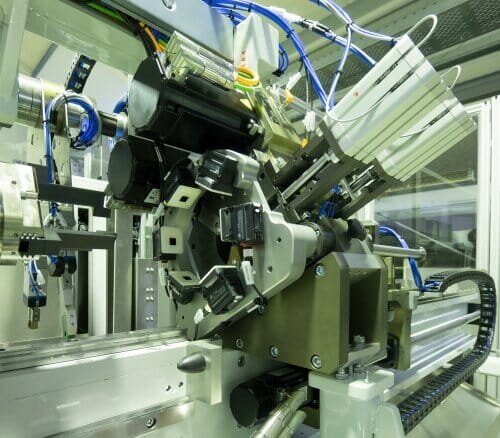Cut to length in no time at all, with no shavings and hardly any burs: Kollmorgen Automation Suite injects some pace into metalworking
The quality of individually prepared pipe sections is measured in terms of precise lengths and edges with no shavings and hardly any burrs. These pipe sections are eventually used for mechanical engineering applications, particularly within the automotive industry. A specialist in this field is FZH Maschinenbau from Großkampenberg. The Vario pipe-cutting system is designed for thin-walled pipes and works in tandem with a motion control solution from Kollmorgen. To help design the drive and control technology, Eifel-based company sought assistance from the engineering experts at Quality Automation GmbH.The first element of the equipment used for precise cutting to length of pipes with different cross sections and made of different alloys is a drum magazine, which serves as a kind of buffer for blanks. Next, a servo-motor-driven handling system with tilting and linear axes automates the feeding of the cutting equipment. The focal point of the process of cutting pipes to length is the cutting head, with the pipe to be cut placed in the middle of this by a linear axis with a gripper unit. A mark indicates where the three circular blades will make contact with the surface. This cutting mark is made by a laser unit, during the earlier handling process, in accordance with the requirements of the production job at hand. The mark is detected by an optical sensor, which FZH has integrated into the cutting head.
Automation from a single source
For complex processes, the Eifel-based engineering firm collaborates closely with Quality Automation GmbH (QA) as part of a long-standing partnership. For the purposes of this project, the system partner of Kollmorgen, based in Stolberg near Aachen, was appointed to create and implement a total automation package for the equipment. “We were responsible for the electrical design, for CE documentation, for building the control cabinet, for software development and ultimately for commissioning the equipment too,” explains Friedhelm Steffens, a member of the management team at QA. The aim was also to automate the cutting head in such a way that subsequent operators would be able to use the equipment for various cross sections, wall thicknesses and materials when working with pipes. FZH clients are mainly from the automotive supply industry. “It is important to ensure flexibility so different types of orders, including small runs, can be produced economically,” stresses Friedhelm Steffens.
QA combined two servo drives to actuate the cutting head. The so-called lever-type supporting disk moves three circular cutting blades, at a defined rotational speed, along the outer edge of the pipe to be cut. The cam disk axis then ensures the three blades are lowered towards the material with a precisely defined profile guide. This arrangement is coordinated and controlled by the AKD PDMM from Kollmorgen. The device combines freely programmable motion control with a servo inverter – all in a single unit. The AKD PDMM drives the lever-type supporting disk and also controls another Kollmorgen AKD servo controller via an EtherCAT communication arrangement. In terms of controlling the actual equipment, the AKD PDMM communicates in turn via Profinet with the Siemens control system (acting as the Profinet master).
Simple motion programming
QA took care of all motion sequences and synchronization of the two drives with the help of the Kollmorgen Automation Suite (KAS). The development platform is integrated into the AKD PDMM. This means the servo amplifier has both high-performance PLC and motion control functionality. Sequences are also quick and easy to program via the graphic programming environment known as Pipe Network. Also there are five standardized languages available which are associated with IEC 61131-3 for sequence control purposes as well as PLCopen motion control function modules (for motion control).
Working with Pipe Network is one of the highlights of the Kollmorgen Automation suite. Pipe Network enables FZH to unravel the complex relationships within the cutting process and represent them on a modular basis. This makes it possible to set each partial motion as a separate entity and independently of the others. As a result of this modularity in terms of engineering, it is really easy to come up with the optimal cutting process for any pipe (especially as pipes come in different materials, wall thicknesses and diameters). During cutting, the lever-type supporting disk and cam disk are synchronized, with the blade making a circular movement around the pipe. A superimposed motion involving the cam disk (implemented via a motion task or electronic cams) lowers the blades into the material and cuts the pipe. With hard materials – particularly precious metals – a scaled electronic cam disk kicks in when the lowering motion is initiated. It ensures the blades speed up initially as they are lowered into the material. The speed then decreases and continues to do so – regardless of the thickness of the wall still to be cut. This precise form of motion control means that even duplex stainless steels can be cut with no shavings and hardly any burs.
But coming back to Pipe Network, this clearly and precisely replicates machine architecture, including dependencies between the axes of an application, in a very short space of time. It is almost like users can “draw” their machine, while programming it at the same time. The work could be likened to a sophisticated form of mechatronic drive programming, which engineering professionals with no specific programming knowledge would also be able to master.
Background: The otherwise very complex programming in Pipe Network is replaced by a graphic description with drag-and-drop function. Starting from a virtual master, all functions and relationships between components as well as all movements and settings can be defined with graphic description blocks.
In terms of the cutting head, this approach translates into a cam-controlled feed and opening motion for the cutter wheels. “From our point of view, this offers clear advantages compared with conventional cutting processes,” explains Friedhelm Steffens. First of all, the cutting blades approach the pipe at considerable speed – before slowing down, without actually stopping, as they cut through the pipe until they reach the end position. It then returns to its original position, but again at speed (with productivity in mind).
A broad range of production applications
The core of the process is fixed, but the details are universally adaptable. This has allowed FZH and QA to develop an overall solution for cutting all commonly available materials. The Vario pipe-cutting system can process diameters of 4 to 120 mm with wall thicknesses of between 0.1 and 2.5 mm (1.5 mm for stainless steel). There is no need for coolants or lubricants either, which is another plus. “The process is a clean one,” points out Steffens. The flexibility of the motion control solution makes it possible to adjust the cutting head to new pipe cross sections or different materials, almost at the push of a button. Formulations can be selected from the control panel. Individual adjustments can also be made here – to things like feed speed.







